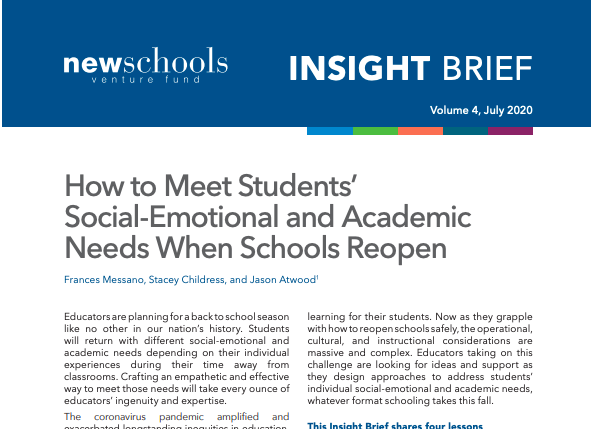By Amy Omand, Chief Financial Officer, NewSchools Venture Fund

The economic outlook in the world has changed rapidly in the past few months. The unemployment rate is at historic highs, businesses are struggling to make ends meet, and each news cycle triggers volatility in the stock markets. The nonprofit sector, which accounts for 10% of the U.S. economy is not immune to these changes. Among organization leaders who weathered the financial turmoil of 2008, there is an intense worry that the coronavirus could devastate charities even more than the Great Recession did.
As a result, nonprofit organizations, big and small, are taking stock of their financial outlook and making necessary adjustments to continue delivering on their missions. If an organization can’t raise additional philanthropic funds or their earned revenue potential is severely diminished, they may find themselves forced to downsize or fold. But there is another, less common option: the nonprofit merger.
As organizations are building scenarios for what their future may look like, they should consider if a nonprofit merger is right for them. When done well, it is an effective strategy to ensure their programs and services withstand a faltering economy.
Mergers, however, are tricky. The process is fraught with challenges that can derail the endeavor and therefore requires careful deliberation. Here are five key things to keep in mind when contemplating a merger:
- Prioritize mission and culture alignment over cost savings. The most successful nonprofit mergers are a result of a strategic, forward-looking process to determine if the two merging organizations have closely aligned missions, cultures, and advantageous position in their nonprofit ecosystem. A common failure of nonprofit mergers is prioritizing cost-savings over mission and culture alignment. If missions and cultures aren’t aligned, the merger is likely to fall apart, and overhead expense reductions won’t matter.
- Develop criteria and seek out potential nonprofit partners that align with them. The next step is to identify a potential partner organization with a predetermined and uniformly applied process. Candidates for a merger are usually (but not always!) obvious. They likely have similar strategies (two inner-city afterschool programs) or complementary strategies (a homeless shelter and an employment program) and compete for staff, donors, or board members.
- Assess the compatibility of senior leaders and board members. The next steps are to ensure that senior leaders and board members are aligned on the merged organization’s vision, mission, and activities as well as the merging process itself. A common failure of nonprofit mergers occurs when organizational leaders have difficulty working through a combined organization’s leadership structure. Personalities and egos can regretfully get in the way of mission alignment.
- Consider hiring a third party to support you throughout the process. One way to mitigate the risk of leadership conflict is to call upon an expert to facilitate the conversations. Consultants are an objective third party that assists with both the nuts and bolts of merging entities, as well as adopting best practices in merging cultures. It may be difficult to justify a consultant’s cost amid strained finances, but the investment will pay dividends if a merged organization continues to operate in the future.
- Enlist your board, key funders, and other trusted partners to support these efforts. Nonprofit board members should also be deeply engaged in scenario planning and assessing mergers. And ensure you are engaging key funders as well, as they may be able to provide a grant to support integration work.
Mergers in the nonprofit sector tend to lag behind the private sector in an economic downturn. Unlike the private sector, there is a lack of matchmakers in the ecosystem; therefore, the onus is on organizational leaders to include a potential merger as an option. The coronavirus-induced economic downturn has just begun, so now is the time to consider whether a merger is the best way to sustain a nonprofit’s social impact.



